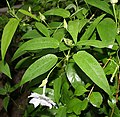| Thunbergia | |
|---|---|

| |
| Flowers of Thunbergia alata | |
| Scientific classification | |
| Kingdom: | Plantae |
| Clade: | Tracheophytes |
| Clade: | Angiosperms |
| Clade: | Eudicots |
| Clade: | Asterids |
| Order: | Lamiales |
| Family: | Acanthaceae |
| Subfamily: | Thunbergioideae |
| Genus: | Thunbergia Retz. (1780)[1] |
| Species[2] | |
|
150; see text | |
| Synonyms[2] | |
| |
Thunbergia is a genus of flowering plants in the family Acanthaceae. It includes 150 species native to tropical and subtropical regions of sub-Saharan Africa, Madagascar, southern Asia, New Guinea, and Australia.[2] Thunbergia species are vigorous annual or perennial vines and shrubs growing to 2–8 m tall. The generic name honours the Swedish naturalist Carl Peter Thunberg (1743-1828).
Its members are known by various names, including thunbergias and clockvine. Thunbergia on its own usually refers to Thunbergia grandiflora, while Thunbergia alata is often known as black-eyed Susan vine or just black-eyed Susan (not to be confused with other flowers called black-eyed Susan). Orange clockvine is the name of Thunbergia gregorii.
Thunbergias are frequent garden escapes, becoming invasive species; T. grandiflora, T. fragrans, and T. laurifolia are considered weeds in Australia.[3]
Selected species[edit]
150 species are accepted.[2] Selected species include:
- Thunbergia alata Bojer ex Sims
- Thunbergia annua Hochst. ex Nees
- Thunbergia atriplicifolia E.Mey. ex Nees[4]
- Thunbergia battiscombei Turrill
- Thunbergia coccinea Wall. ex D.Don
- Thunbergia cordata Colla
- Thunbergia elegans Borzí
- Thunbergia erecta (Benth.) T. Anderson
- Thunbergia fragrans Roxb.
- Thunbergia gibsonii S. Moore
- Thunbergia grandiflora Roxb.
- Thunbergia gregorii S.Moore
- Thunbergia ikbaliana De Wild.
- Thunbergia laurifolia Lindl.
- Thunbergia lutea T. Anderson
- Thunbergia mysorensis (Wight) T.Anderson
- Thunbergia natalensis Hook.
- Thunbergia vogeliana Benth.
- Thunbergia wightiana T.Anderson[5]
Formerly placed here[edit]
- Meyenia hawtayneana (Wall.) Nees (as T. hawtayneana Wall.)[5]
Gallery[edit]
References[edit]
- ^ "Genus: Thunbergia Retz". Germplasm Resources Information Network. United States Department of Agriculture. 2007-10-05. Archived from the original on 2012-10-09. Retrieved 2010-10-30.
- ^ a b c d Thunbergia Retz. Plants of the World Online. Retrieved 7 February 2024.
- ^ Weeds Australia, National Weeds Strategy, retrieved 27 March 2015
- ^ "Red List of South African Plants". SANBI. Retrieved 7 January 2019.
- ^ a b "GRIN Species Records of Thunbergia". Germplasm Resources Information Network. United States Department of Agriculture. Archived from the original on 2015-09-24. Retrieved 2010-10-30.
External links[edit]
- A Tale of Two Susans II - non-scholarly essay on the etymology and history of Thunbergia (and Carl Peter Thunberg)






Well, that’s interesting to know that Psilotum nudum are known as whisk ferns. Psilotum nudum is the commoner species of the two. While the P. flaccidum is a rare species and is found in the tropical islands. Both the species are usually epiphytic in habit and grow upon tree ferns. These species may also be terrestrial and grow in humus or in the crevices of the rocks.
View the detailed Guide of Psilotum nudum: Detailed Study Of Psilotum Nudum (Whisk Fern), Classification, Anatomy, Reproduction